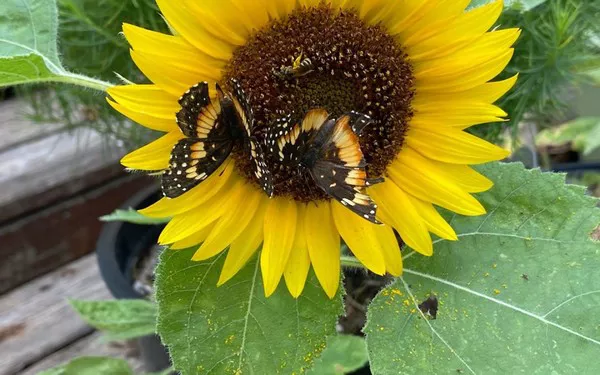Bees play a crucial role in pollinating plants, contributing to the growth and reproduction of various crops and wildflowers. As gardeners and nature enthusiasts, we have the opportunity to support bee populations by creating pollinator-friendly gardens. By planting flowers that attract and provide nourishment for bees, we can help sustain these essential pollinators. In this article, we will explore a variety of flowers that are particularly attractive to bees and provide a colorful and vibrant addition to any garden.
1. Native Wildflowers
Native wildflowers are well-adapted to local climates and often offer an abundant source of nectar and pollen for bees. By incorporating native flowers into your garden, you can create a natural habitat that attracts a diverse range of bee species. Some popular native wildflowers for bees include:
Purple Coneflower (Echinacea purpurea): Known for its striking purple petals and prominent cone-shaped center, this perennial wildflower is a favorite of many bee species.
Black-eyed Susan (Rudbeckia hirta): With its vibrant yellow petals and dark centers, black-eyed Susans are a magnet for bees and other pollinators.
Goldenrod (Solidago spp.): These tall, yellow-flowering plants provide a late-season source of nectar for bees when other flowers are scarce.
Bee Balm (Monarda spp.): Bee balm, also known as wild bergamot, produces clusters of colorful flowers that attract bees, butterflies, and hummingbirds.
2. Lavender (Lavandula spp.)
Lavender is not only prized for its delightful fragrance and beauty but is also highly attractive to bees. Bees are particularly fond of the nectar-rich flowers, which are typically shades of purple or blue. Planting lavender in your garden not only provides a visual treat but also serves as a valuable food source for bees.
3. Sunflowers (Helianthus spp.)
Sunflowers are not only iconic and cheerful additions to gardens but also beloved by bees. The large, vibrant flowers produce copious amounts of nectar and pollen, attracting bees and other pollinators. Sunflowers come in various sizes and colors, allowing you to choose the variety that suits your garden space and aesthetic preferences.
4. Borage (Borago officinalis)
Borage is a herbaceous annual plant with star-shaped, blue flowers that bees find irresistible. The flowers are rich in nectar and provide a valuable food source for bees throughout the summer months. Borage is also an edible plant, and its leaves and flowers can be used in culinary creations, making it a versatile addition to the garden.
5. Salvia (Salvia spp.)
Salvia, commonly known as sage, is a diverse genus of flowering plants that includes a wide range of species and cultivars. Many varieties of salvia, such as Salvia officinalis (common sage) and Salvia nemorosa (meadow sage), produce beautiful flowers that bees find highly appealing. The tubular-shaped flowers are rich in nectar and attract both bees and butterflies.
6. Catmint (Nepeta spp.)
Catmint is a low-maintenance perennial plant that produces clusters of small, tubular flowers in shades of blue or purple. Bees are particularly drawn to catmint due to its abundant nectar. This plant is not only attractive to bees but also acts as a natural deterrent for pests such as aphids, making it a beneficial addition to any garden.
7. Phacelia (Phacelia tanacetifolia)
Phacelia, also known as bee’s friend, is an annual plant with delicate, lavender-blue flowers that form dense clusters. It is highly attractive to bees, often used in agricultural settings as a cover crop to attract pollinators and improve soil health. Phacelia is an excellent choice for gardeners looking to create a bee-friendly habitat.
8. Zinnias (Zinnia spp.)
Zinnias are vibrant annual flowers available in a wide range of colors, shapes, and sizes. These cheerful flowers produce ample nectar, making them a favorite among bees and other pollinators. Planting a variety of zinnia cultivars ensures a continuous supply of nectar throughout the summer, attracting and supporting diverse bee species.
Creating a Bee-Friendly Garden
When planting flowers for bees, there are a few key considerations to keep in mind:
Provide a variety of flowers: Bees are attracted to a diverse range of flower shapes, colors, and sizes. Planting a variety of flowers ensures a continuous supply of nectar and pollen throughout the growing season.
Choose single or semi-double flowers: Single or semi-double flowers, rather than highly hybridized double flowers, provide easier access to nectar and pollen for bees.
Plant in clusters: Planting flowers in clusters or drifts allows bees to forage more efficiently and makes it easier for them to locate the flowers.
Avoid pesticides: Minimize or eliminate the use of pesticides in your garden, as they can be harmful to bees and other beneficial insects. Opt for organic and bee-friendly pest control methods.
Provide water sources: Place shallow dishes or create a small water feature with rocks for bees to safely access water without drowning.
Conclusion
By planting a diverse selection of flowers that attract and nourish bees, we can contribute to the conservation and well-being of these vital pollinators. Native wildflowers, lavender, sunflowers, borage, salvia, catmint, phacelia, and zinnias are just a few examples of the many bee-friendly flowers available. Remember to consider the needs of bees when planning and cultivating your garden, providing them with a continuous and abundant supply of nectar and pollen. By doing so, you can create a vibrant and pollinator-friendly haven that supports both bees and the overall health of your garden ecosystem.


